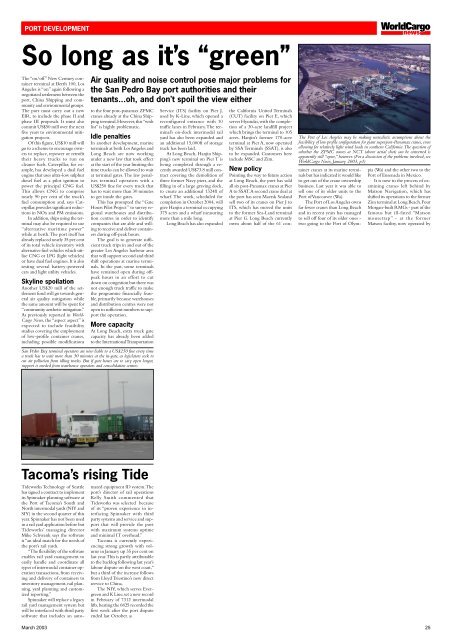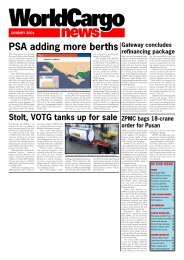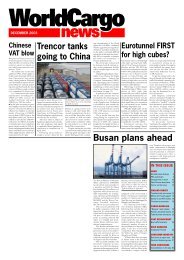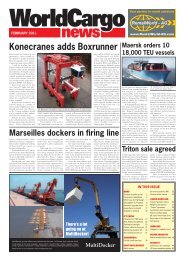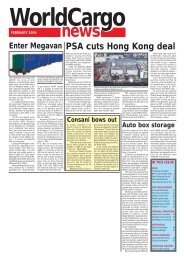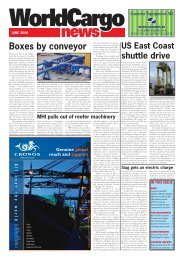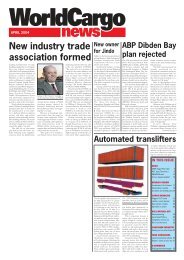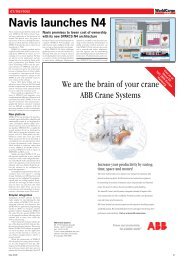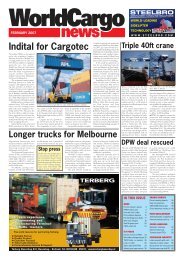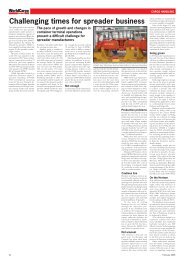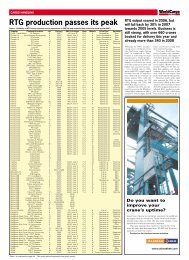March Front Cover - WorldCargo News Online
March Front Cover - WorldCargo News Online
March Front Cover - WorldCargo News Online
You also want an ePaper? Increase the reach of your titles
YUMPU automatically turns print PDFs into web optimized ePapers that Google loves.
PORT DEVELOPMENT<strong>WorldCargo</strong>newsSo long as it’s “green”The “on/off” New Century containerterminal at Berth 100, LosAngeles is “on” again following anegotiated settlement between theport, China Shipping and communityand environmental groups.The port must carry out a newEIR, to include the phase II andphase III proposals. It must alsocommit US$50 mill over the nextfive years to environmental mitigationprojects.Of this figure, US$10 mill willgo to a scheme to encourage ownersto replace, repower or retrofittheir heavy trucks to run oncleaner fuels. Caterpillar, for example,has developed a dual fuelengine that uses ultra-low sulphurdiesel fuel as a pilot ignition topower the principal CNG fuel.This allows CNG to comprisenearly 90 per cent of the truck’sfuel consumption and, says Caterpillar,provides significant reductionsin NOx and PM emissions.In addition, ships using the terminalmay also be required to use“alternative maritime power”while at berth. The port itself hasalready replaced nearly 35 per centof its total vehicle inventory withalternative fuel vehicles which utiliseCNG or LPG (light vehicles)or have dual fuel engines. It is alsotesting several battery-poweredcars and light utility vehicles.Skyline spoilationAnother US$20 mill of the settlementfund will go towards generalair quality mitigation whilethe same amount will be spent for“community aesthetic mitigation.”As previously reported in World-Cargo <strong>News</strong>, the “aspect aspect” isexpected to include feasibilitystudies covering the employmentof low-profile container cranes,including possible modificationsAir quality and noise control pose major problems forthe San Pedro Bay port authorities and theirtenants...oh, and don't spoil the view eitherto the four post-panamax ZPMCcranes already at the China Shippingterminal. However, this “wishlist” is highly problematic.Idle penaltiesIn another development, marineterminals at both Los Angeles andLong Beach are now workingunder a new law that took effectat the start of the year limiting thetime trucks can be allowed to waitat terminal gates. The law penalisesterminal operators with aUS$250 fine for every truck thathas to wait more than 30 minutesto get inside the gates.This has prompted the “GateHours Pilot Project” to survey regionalwarehouses and distributioncentres in order to identifycompanies that are able and willingto receive and deliver containersduring off-peak hours.The goal is to generate sufficienttruck trips in and out of thegreater Los Angeles harbour areathat will support second and thirdshift operations at marine terminals.In the past, some terminalshave remained open during offpeakhours in an effort to cutdown on congestion but there wasnot enough truck traffic to makethe programme financially feasible,primarily because warehousesand distribution centres were notopen in sufficient numbers to supportthe operation.More capacityAt Long Beach, extra truck gatecapacity has already been addedto the International TransportationService (ITS) facility on Pier J,used by K-Line, which opened areconfigured entrance with 10traffic lanes in February. The terminal’son-dock intermodal railyard has also been expanded andan additional 15,000ft of storagetrack has been laid.At Long Beach, Hanjin Shipping’snew terminal on Pier T isbeing completed through a recentlyawarded US$73.8 mill contractcovering the demolition ofthree former Navy piers, and thefilling in of a large graving dock,to create an additional 1324ft ofwharf. The work, scheduled forcompletion in October 2004, willgive Hanjin a terminal occupying375 acres and a wharf measuringmore than a mile long.Long Beach has also expandedthe California United Terminals(CUT) facility on Pier E, whichserves Hyundai, with the completionof a 30-acre landfill projectwhich brings the terminal to 105acres. Hanjin’s former 170-acreterminal at Pier A, now operatedby SSA Terminals (SSAT), is alsoto be expanded. Customers hereinclude MSC and Zim.The Port of Los Angeles may be making unrealistic assumptions about thefeasibility of low profile configuration for giant superpost-Panamax cranes, evenallowing for relatively light wind loads in southern California. The question ofwhether the ZPMC cranes at NCT (above aerial shot) can be converted isapparently still “open,” however. (For a discussion of the problems involved, see<strong>WorldCargo</strong> <strong>News</strong>, January 2003, p1)New policyPointing the way to future actionat Long Beach, the port has soldall six post-Panamax cranes at PierA to SSAT. A second crane deal atthe port has seen Maersk Sealandsell two of its cranes on Pier J toITS, which has moved the unitsto the former Sea-Land terminalat Pier G. Long Beach currentlyowns about half of the 61 containercranes at its marine terminalsbut has indicated it would liketo get out of the crane ownershipbusiness. Last year it was able tosell one of its older units to thePort of Vancouver (Wa).The Port of Los Angeles ownsfar fewer cranes than Long Beachand in recent years has managedto sell off four of its older ones -two going to the Port of Olympia(Wa) and the other two to thePort of Ensenada in Mexico.It is now in the process of examiningcranes left behind byMatson Navigation, which hasshifted its operations to the formerZim terminal at Long Beach. FourMorgan-built RMGs - part of thefamous but ill-fated “Matsonmousetrap” - at the formerMatson facility, now operated bySan Pedro Bay terminal operators are now liable to a US$250 fine every timea truck has to wait more than 30 minutes at the in-gate, as legislators seek tocut air pollution from idling trucks. But if gate hours are to saty open longer,support is needed from warehouse operators and consolidation centresTacoma’s rising TideTideworks Technology of Seattlehas signed a contract to implementits Spinnaker planning software atthe Port of Tacoma’s South andNorth intermodal yards (NIY andSIY) in the second quarter of thisyear. Spinnaker has not been usedin a rail yard application before butTideworks’ managing directorMike Schwank says the softwareis “an ideal match for the needs ofthe port’s rail yards.“The flexibility of the softwareenables rail yard management toeasily handle and coordinate alltypes of intermodal container operationtransactions, from receivingand delivery of containers toinventory management, rail planning,yard planning and customizedreporting.”Spinnaker will replace a legacyrail yard management system butwill be interfaced with third partysoftware that includes an auto-mated equipment ID system. Theport’s director of rail operationsKelly Smith commented thatTideworks was selected becauseof its “proven experience in interfacingSpinnaker with thirdparty systems and service and supportthat will provide the portwith maximum systems uptimeand minimal IT overhead.”Tacoma is currently experiencingstrong growth with volumein January up 35 per cent onlast year. This is partly attributableto the backlog following last year’slabour dispute on the west coast,ºbut a third of the increase followsfrom Lloyd Triestino’s new directservice to China.The NIY, which serves Evergreenand K Line, set a new recordin February of 7312 intermodallifts, beating the 6825 recorded thefirst week after the port disputeended last October. ❏<strong>March</strong> 2003 25


